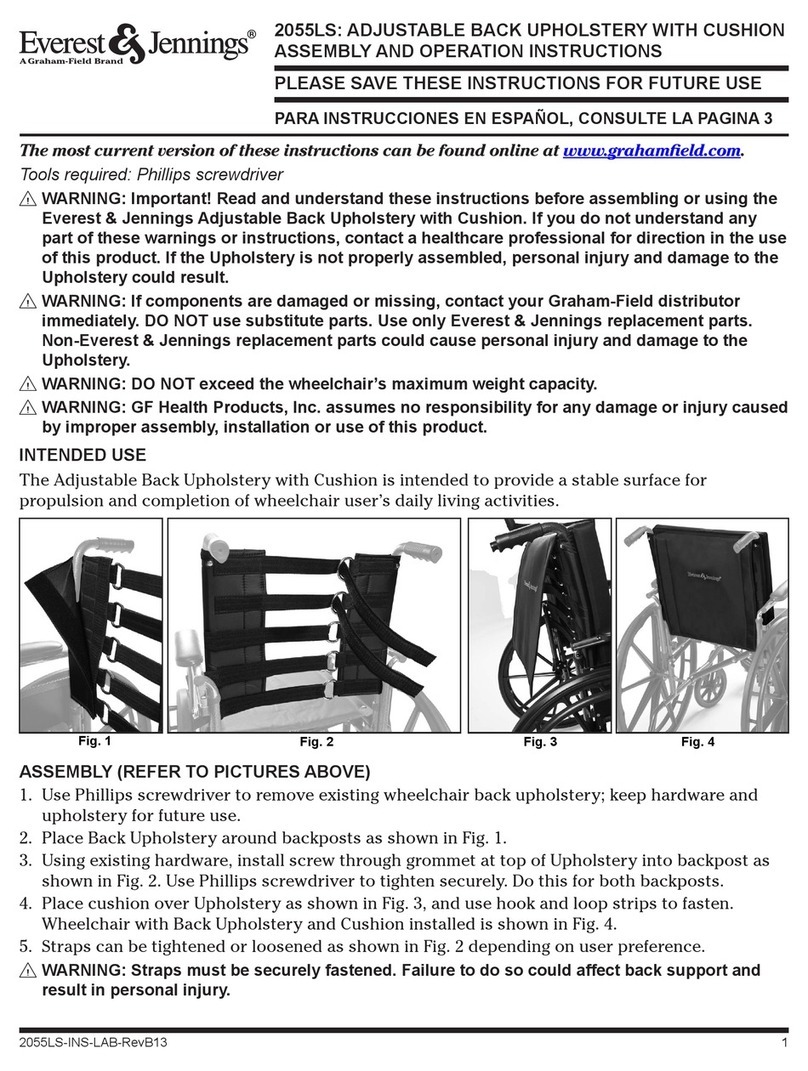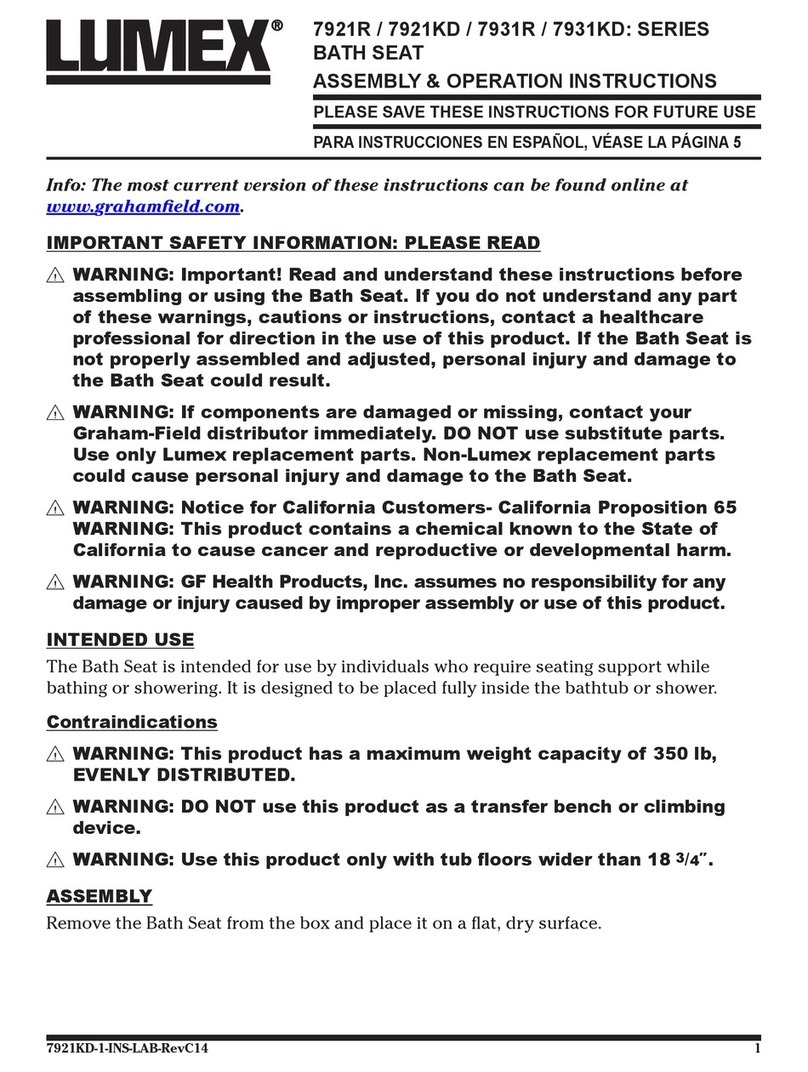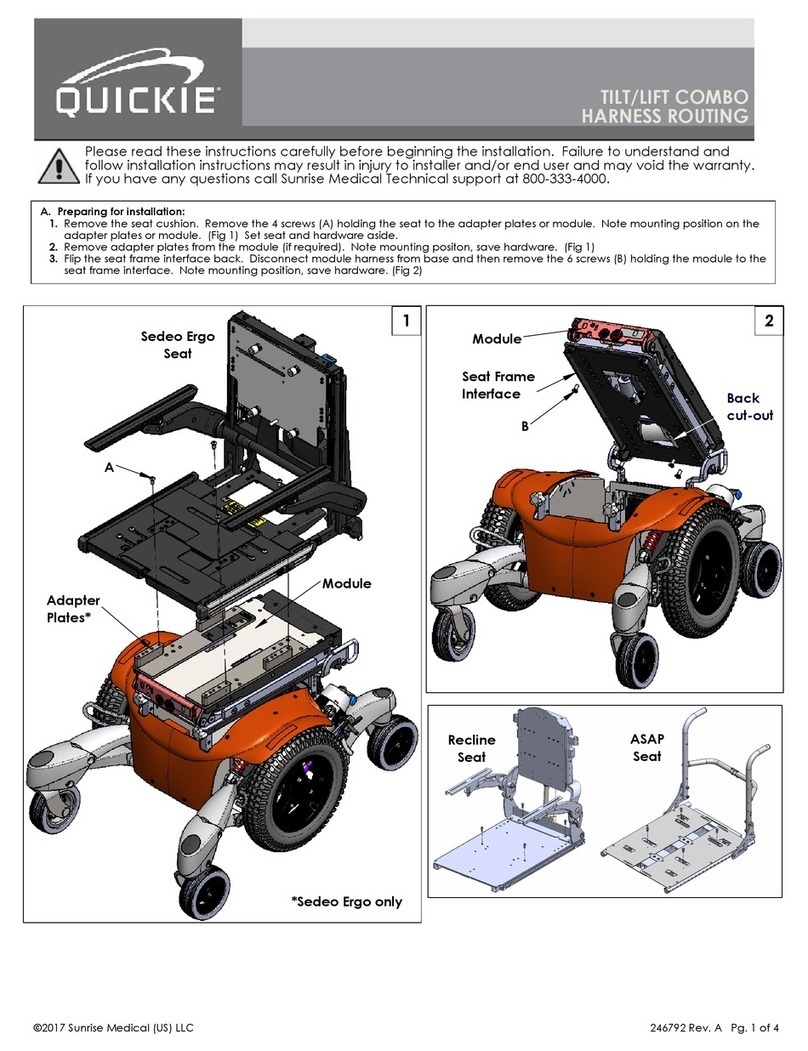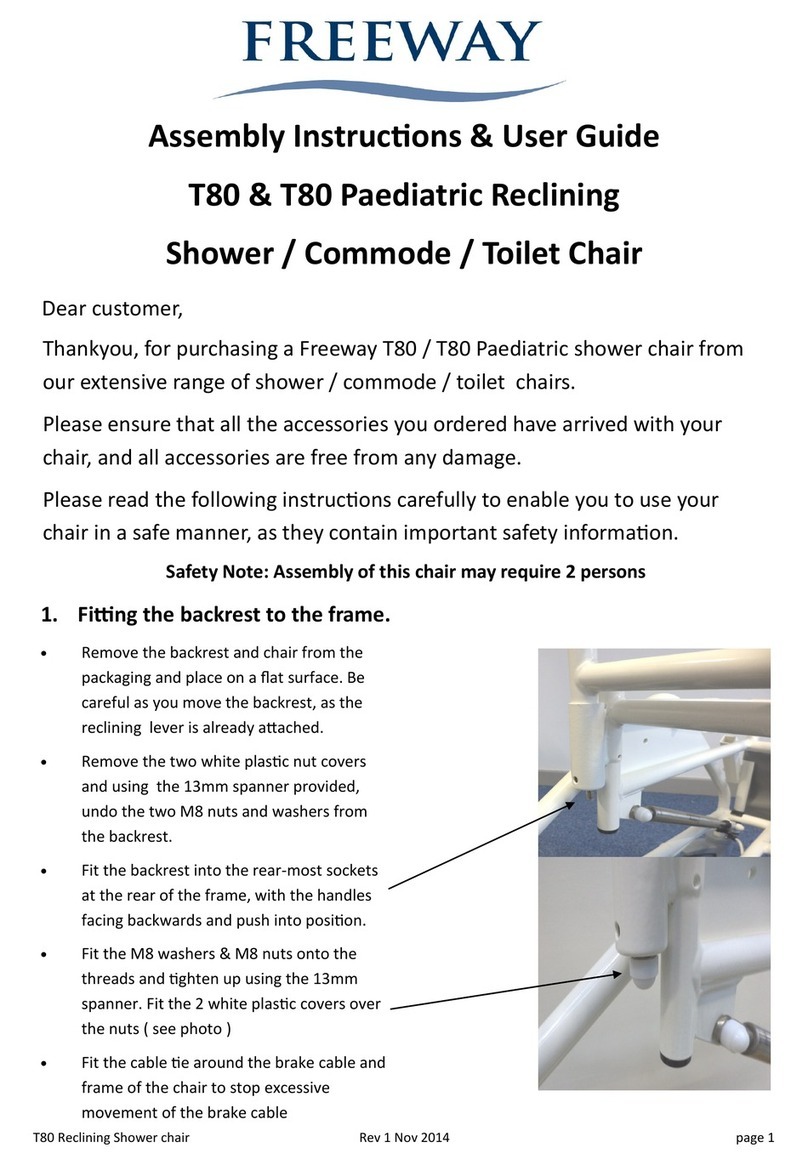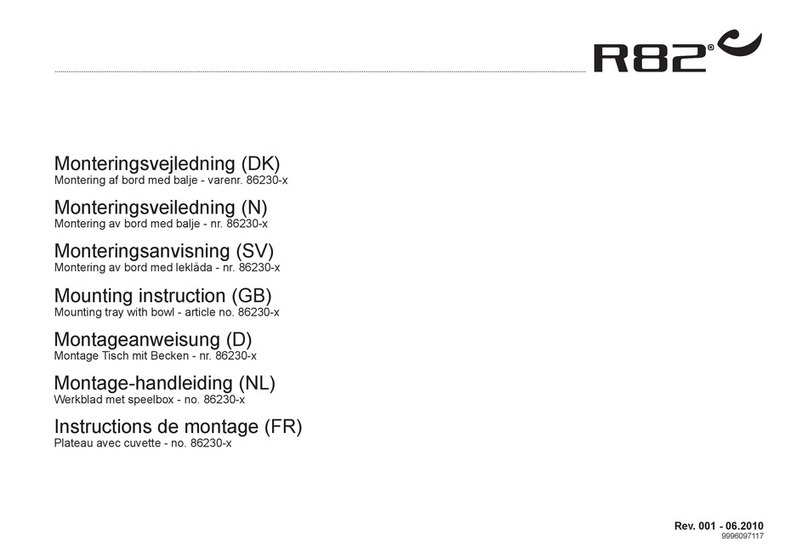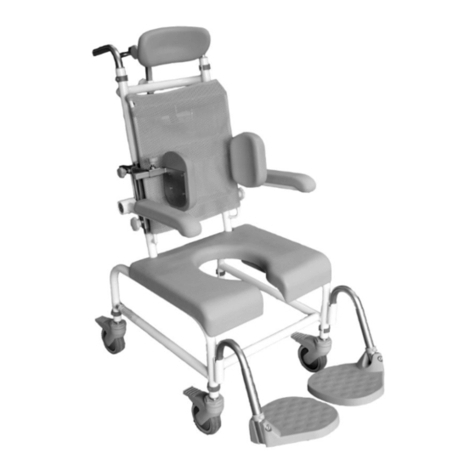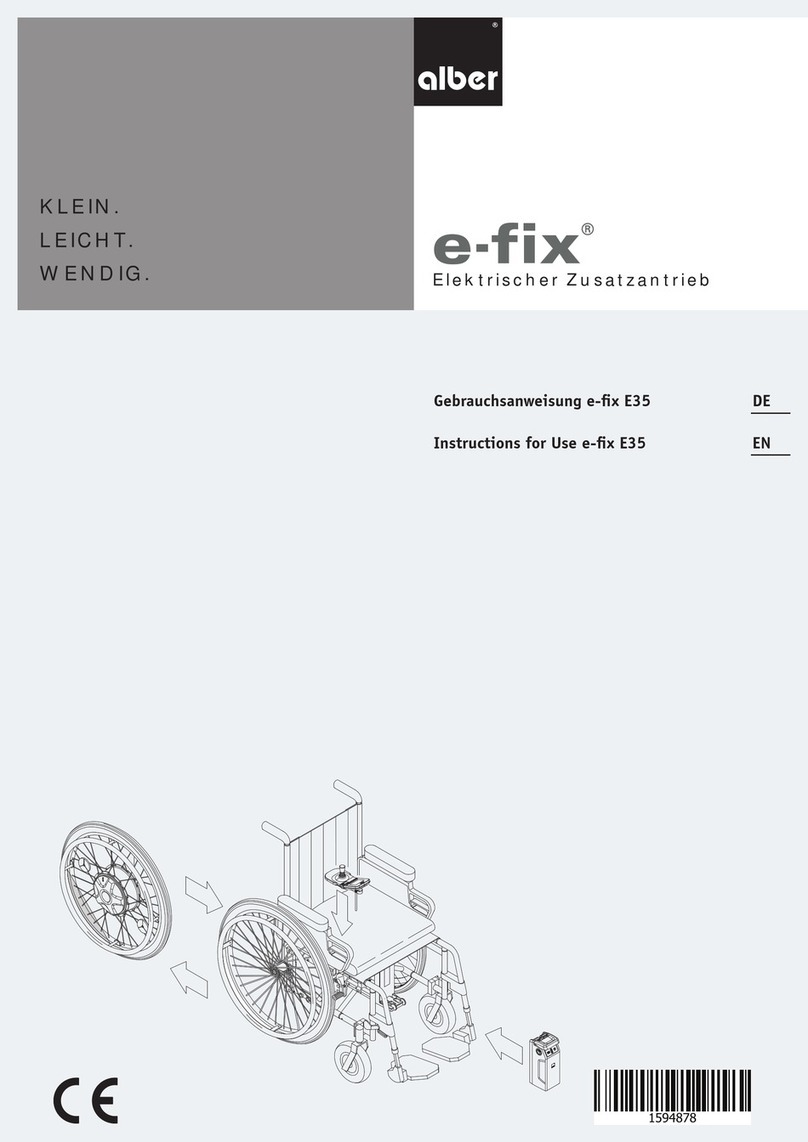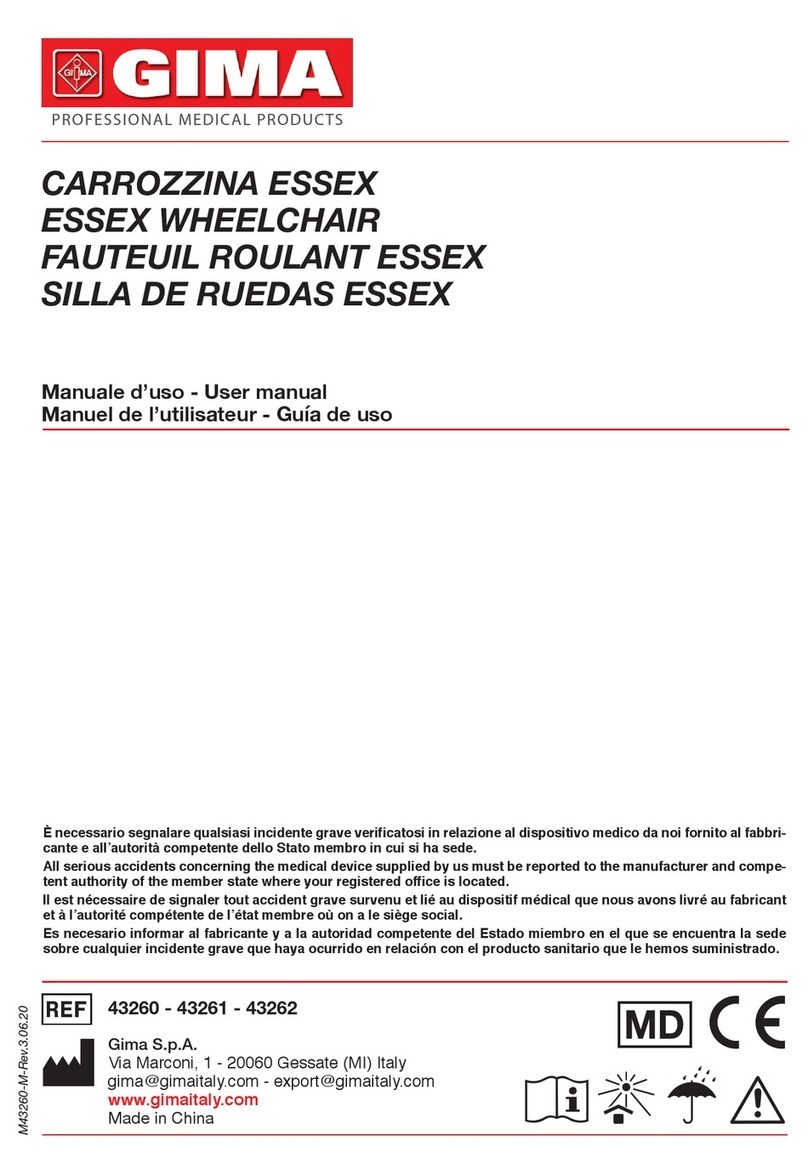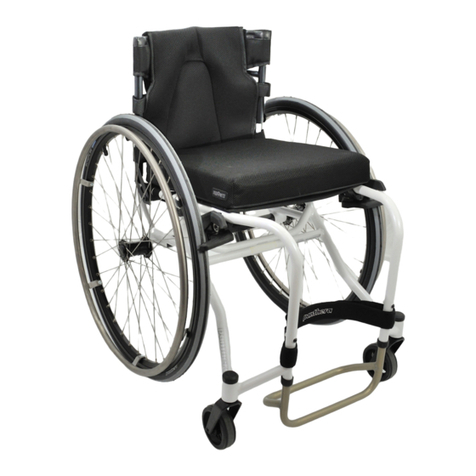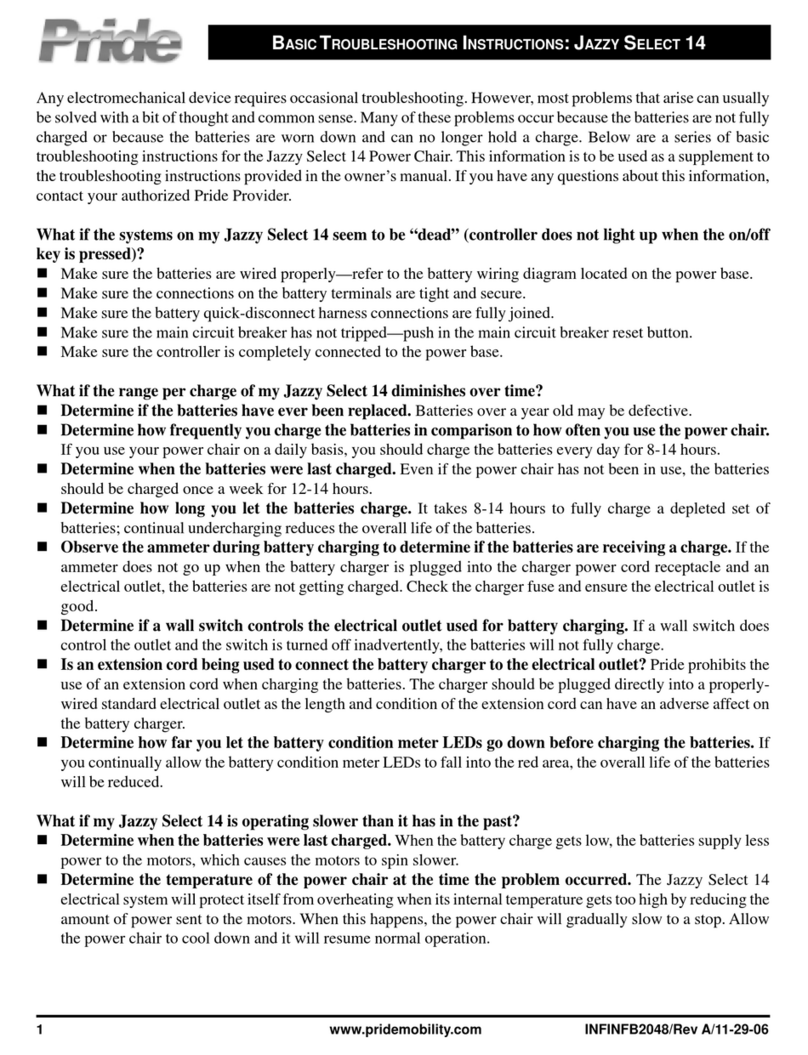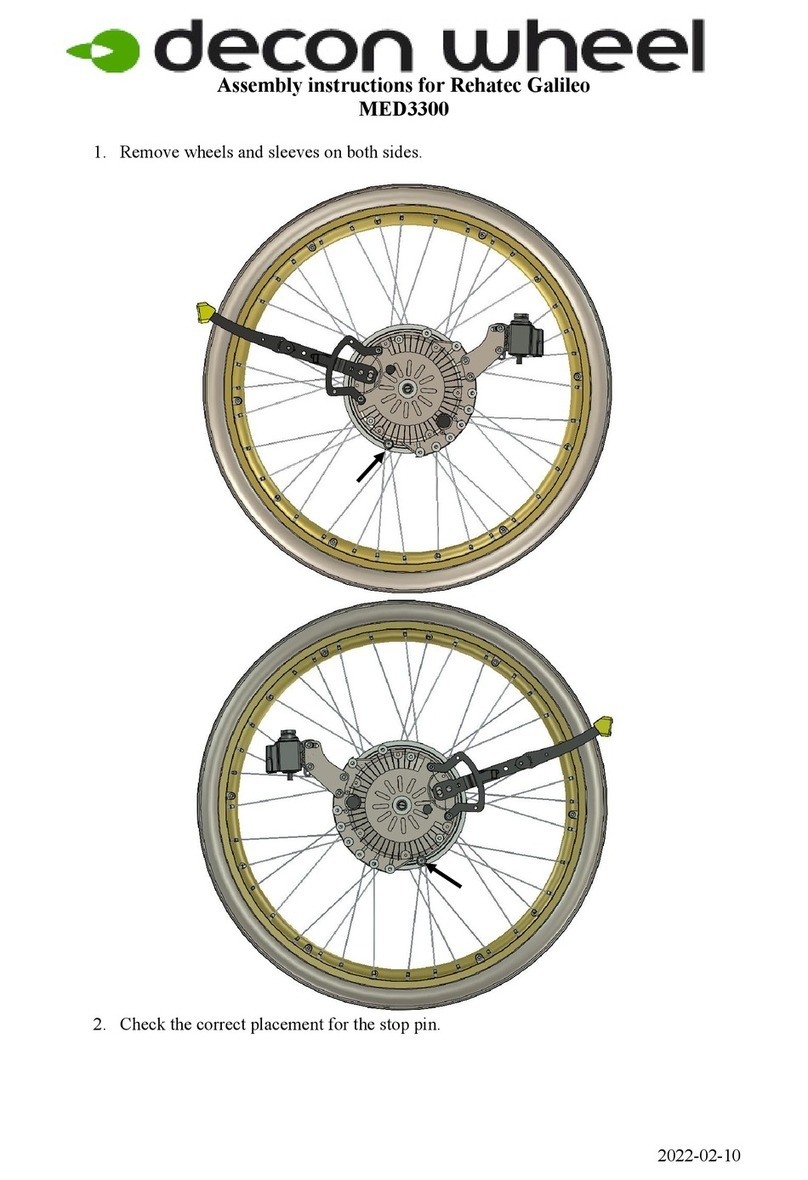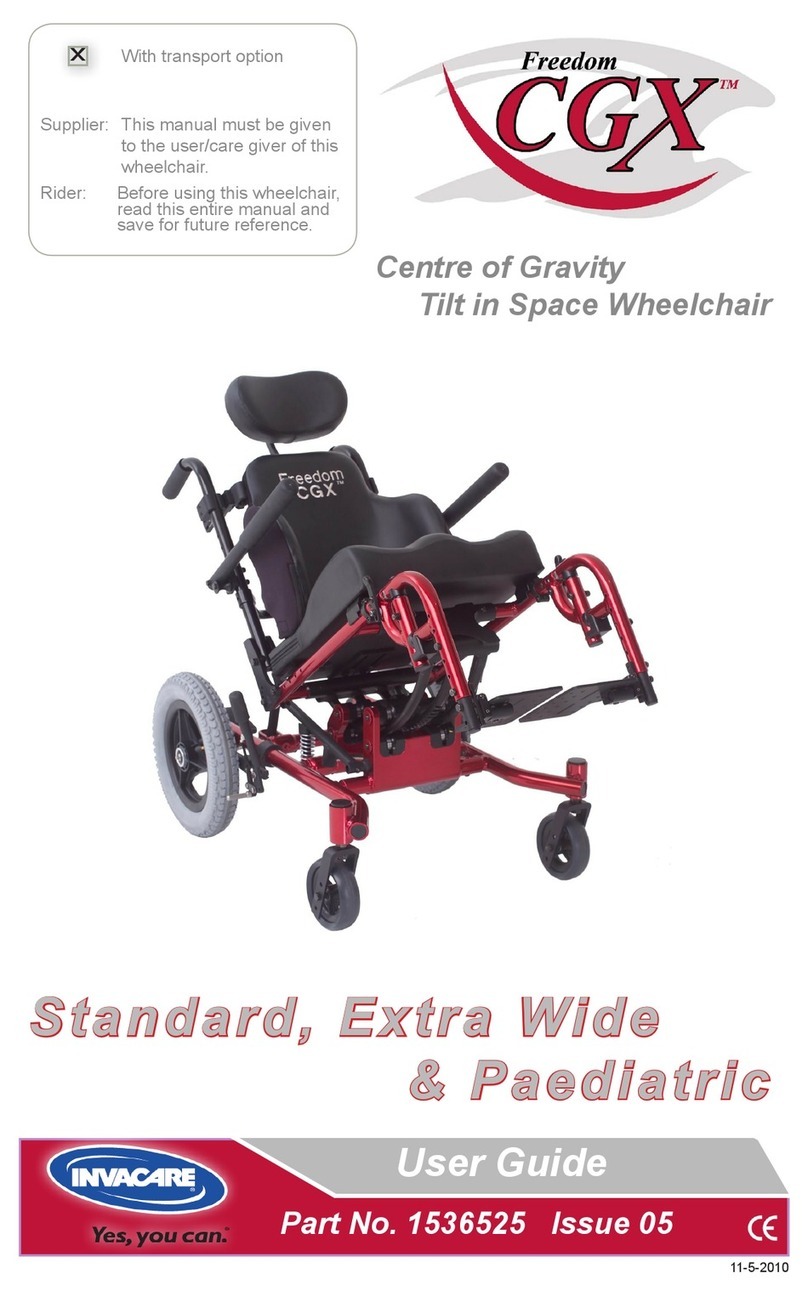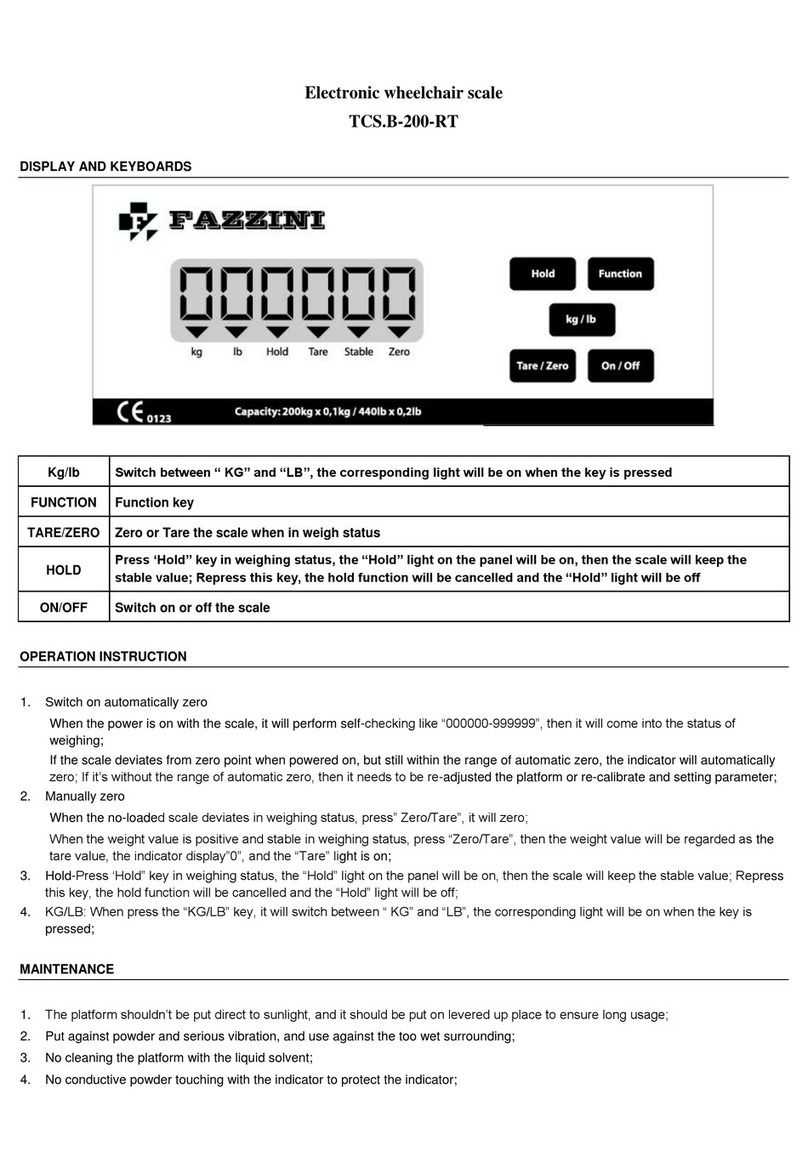Graham Field Everest Jennings PURETILT PT3000-18 Installation and user guide

EJ_PT3000-18-INS-LAB-RevC22
PURETILT™ PT3000-18
MANUAL TILT WHEELCHAIR
SERVICE AND MAINTENANCE MANUAL
SAVE THIS MANUAL FOR FUTURE USE.

CONTENTS
1 INTRODUCTION .......................................................................................................................................................................................................................3
INTENDED USE ........................................................................................................................................................................................................................3
STATEMENTS OF SIGNIFICANCE ..........................................................................................................................................................................................3
2 IMPORTANT SAFETY PRECAUTIONS ...................................................................................................................................................................................4
WARNINGS ...............................................................................................................................................................................................................................4
3 FEATURES................................................................................................................................................................................................................................6
PURETILT LABELS ..................................................................................................................................................................................................................7
4 GETTING STARTED .................................................................................................................................................................................................................8
OPERATING THE WHEEL LOCKS..........................................................................................................................................................................................8
INSTALLING THE FRONT CASTERS......................................................................................................................................................................................8
INSTALLING AND OPERATING THE ANTI-TIPPERS.............................................................................................................................................................9
INSTALLING THE HEADREST ................................................................................................................................................................................................9
UNFOLDING AND FOLDING THE WHEELCHAIR................................................................................................................................................................10
UNFOLDING THE WHEELCHAIR ...................................................................................................................................................................................10
FOLDING THE WHEELCHAIR ........................................................................................................................................................................................10
5 HANDLING TIPS..................................................................................................................................................................................................................... 11
BALANCE ............................................................................................................................................................................................................................... 11
TRANSFER ............................................................................................................................................................................................................................. 11
REACHING / BENDING ..........................................................................................................................................................................................................12
REACHING / BENDING FORWARD OR SIDEWARD .....................................................................................................................................................12
REACHING / BENDING BACKWARD.............................................................................................................................................................................12
RAMPS AND INCLINES .........................................................................................................................................................................................................13
ASCENT ...........................................................................................................................................................................................................................13
DESCENT.........................................................................................................................................................................................................................13
CURBS ....................................................................................................................................................................................................................................13
CURBS — WITH ATTENDANT........................................................................................................................................................................................14
GOING UP (METHOD 1) ..................................................................................................................................................................................................14
GOING UP (METHOD 2) ..................................................................................................................................................................................................14
GOING DOWN..................................................................................................................................................................................................................14
STAIRS AND ESCALATORS..................................................................................................................................................................................................14
WEIGHT TRAINING ................................................................................................................................................................................................................14
6 OPERATION............................................................................................................................................................................................................................15
ROTATING THE ARMS...........................................................................................................................................................................................................15
OPERATING SEAT TILT .........................................................................................................................................................................................................16
OPERATING SEAT TILT: BY USER.................................................................................................................................................................................16
OPERATING SEAT TILT: BY CAREGIVER .....................................................................................................................................................................16
7 ADJUSTMENTS......................................................................................................................................................................................................................17
REAR WHEELS AND CASTERS ...........................................................................................................................................................................................17
BACK ......................................................................................................................................................................................................................................17
ADJUST BACK HEIGHT..................................................................................................................................................................................................17
REMOVE THE BACK.......................................................................................................................................................................................................17
HEADREST .............................................................................................................................................................................................................................18
ADJUST HEADREST HEIGHT ........................................................................................................................................................................................18
LEGREST / FOOTPLATE .......................................................................................................................................................................................................18
ADJUST LEGREST / FOOTPLATE LENGTH .................................................................................................................................................................18
ADJUST LEGREST ANGLE ............................................................................................................................................................................................19
RETRACT LEGREST FOR STORAGE OR FOOT PROPULSION .................................................................................................................................19
SEAT .......................................................................................................................................................................................................................................20
SEAT TILT FORCE...........................................................................................................................................................................................................20
ADJUST SEAT TILT FORCE ...........................................................................................................................................................................................21
WHEEL LOCKS ......................................................................................................................................................................................................................22
ADJUST WHEEL LOCKS ................................................................................................................................................................................................22
8 TRANSPORTING THE PURETILT .........................................................................................................................................................................................23
PREPARATION FOR TRANSPORT / FOLDING THE WHEELCHAIR ..................................................................................................................................23
FOLD BACK FORWARD .................................................................................................................................................................................................23
TRANSPORTING THE WHEELCHAIR ..................................................................................................................................................................................23
9 MAINTENANCE ......................................................................................................................................................................................................................24
SERVICE MANUAL.................................................................................................................................................................................................................24
DO-IT-YOURSELF MAINTENANCE.......................................................................................................................................................................................24
LIST OF TOOLS...............................................................................................................................................................................................................25
GENERAL CARE .............................................................................................................................................................................................................25
CHECK AT LEAST EVERY WEEK .........................................................................................................................................................................................25
CHECK TIRE WEAR ........................................................................................................................................................................................................25
CHECK HANDRIMS.........................................................................................................................................................................................................25
CHECK WHEEL LOCK ENGAGEMENT .........................................................................................................................................................................25
CHECK ANTI-TIPPERS ...................................................................................................................................................................................................25
WIPE OFF FRAME...........................................................................................................................................................................................................25
CHECK AT LEAST EVERY MONTH.......................................................................................................................................................................................25
CHECK HANDGRIPS.......................................................................................................................................................................................................25
CHECK UPHOLSTERY....................................................................................................................................................................................................26
CLEAN UPHOLSTERY AND PLASTIC COMPONENTS ................................................................................................................................................26
CHECK REAR WHEEL ADJUSTMENT...........................................................................................................................................................................26
CHECK ARMS..................................................................................................................................................................................................................26
CHECK ARM AND BACK LOCKING LATCHES.............................................................................................................................................................26
CHECK LEGREST AND FOOTPLATE ............................................................................................................................................................................26
CHECK AT LEAST EVERY THREE MONTHS .......................................................................................................................................................................26
CLEAN FRAME................................................................................................................................................................................................................26
CHECK CASTER AXLE AND STEM ROTATION ............................................................................................................................................................26
CHECK AT LEAST EVERY SIX MONTHS .............................................................................................................................................................................26
MAINTENANCE CHECK..................................................................................................................................................................................................26
CHECK CASTER AND REAR WHEEL BEARINGS........................................................................................................................................................26
10 TROUBLESHOOTING ............................................................................................................................................................................................................27
11 SPECIFICATIONS...................................................................................................................................................................................................................28
12
DISPOSAL ..............................................................................................................................................................................................................................29
13
LIMITED WARRANTY.............................................................................................................................................................................................................30
14 INDEX......................................................................................................................................................................................................................................31
2
EJ_PT3000-18-INS-LAB-RevC22 www.grahamfield.com

READ THIS MANUAL BEFORE OPERATING YOUR WHEELCHAIR
1 INTRODUCTION
Thank you for choosing an Everest & Jennings product. Important safety, operating, and
maintenance instructions that warrant your attention are included in this user manual. Read the
entire manual carefully before operating your new wheelchair, and refer to it as often as necessary
to help maintain good performance standards. If you have further questions, call Graham-Field
Customer Service at 1.770.368.4700.
Consult your healthcare professional and GF authorized distributor for assistance in developing
and learning safe and effective techniques for performing your daily activities according to your
individual physical abilities and needs, and to make certain that your wheelchair is properly
prescribed and adjusted for your use.
The safety precautions in this manual are general warnings intended to be used only as
basic guidelines. You may nd it necessary to develop your own methods for safely solving
frequently encountered challenges. Again, consult your professional medical advisors for their
recommendations about safety methods, and never hesitate to ask for their assistance.
Your wheelchair should receive frequent, regularly scheduled maintenance, including an
inspection of the mechanical parts, to ensure proper operation. Some suggested inspection
procedures, troubleshooting procedures, and adjustment procedures are included in this manual.
When it comes to service and repair, remember that your GF authorized distributor knows your
wheelchair best.
The person performing adjustments on the PureTilt has the responsibility of making certain that
the user can safely operate the wheelchair with the adjustments selected. This person must
evaluate the user's ability, weight, physical condition, the environment in which the wheelchair
will be used, and the terrain over which the wheelchair will travel. We recommend the use of
anti-tippers at all times.
INTENDED USE
The PureTilt's intended use is to provide mobility to those who are unable to ambulate safely or
are restricted to a sitting position. The PureTilt is a manual indoor / outdoor wheelchair suitable
for frequent users who require a portable wheelchair.
STATEMENTS OF SIGNIFICANCE
Please note the following special statements, used throughout this manual, and their signicance:
WARNING: Indicates a potential hazard situation or unsafe practice that, if not avoided,
could result in death or serious personal injury.
CAUTION: Indicates a potential hazard situation or unsafe practice that, if not avoided,
could result in minor or moderate personal injury.
sNOTICE: Indicates a potential hazard situation or unsafe practice that, if not avoided, could
result in product or property damage.
Info: Provides application recommendations or other useful information to ensure that you get
the most from your product.
3
EJ_PT3000-18-INS-LAB-RevC22 www.grahamfield.com

2 IMPORTANT SAFETY PRECAUTIONS
IMPORTANT SAFETY PRECAUTIONS: ALWAYS FOLLOW THESE SAFETY PRECAUTIONS
WHEN USING YOUR WHEELCHAIR. FAILURE TO DO SO COULD RESULT IN PERSONAL
INJURY TO YOU OR OTHERS OR DAMAGE TO YOUR WHEELCHAIR.
Safety requires the constant attention of the wheelchair user and the attendant. It is extremely
important to learn and always use safe methods of performing basic daily activities. Always
consult your healthcare professional to determine those methods most suitable for your
individual abilities.
Protect yourself and your wheelchair by having your PureTilt serviced regularly. Whenever
any part of your PureTilt is not functioning properly, contact your GF authorized distributor
immediately, as a hazardous situation could result, causing personal injury or damage to your
wheelchair. ONLY EXCELLENT CONDITION IS ACCEPTABLE WHERE SAFETY IS CONCERNED.
Periodic inspection, adjustment, and replacement of worn parts will provide many years of superb
performance.
WARNINGS
WARNING: PureTilt maximum weight capacity is 300 lb (136.1 kg), EVENLY DISTRIBUTED.
WARNING: We recommend the use of anti-tippers at all times to prevent the PureTilt from
tipping backward and causing injury. Anti-tippers must be installed in the downward
position.
WARNING: Keep hands free of moving parts.
WARNING: Do not operate this wheelchair on streets or roadways.
WARNING: Do not operate this wheelchair on hilly or rough terrain, sand, mud, snow,
wet or icy surfaces, or surfaces with impaired traction. Ensure that pathway is clear of all
obstacles.
WARNING: Do not operate this wheelchair in shower, pool, or water.
WARNING: Do not turn wheelchair while going downhill, as wheelchair could tip over.
WARNING: Do not attempt inclines without anti-tippers installed in the downward position.
Do not attempt any incline or decline greater than six degrees (10% grade, or one foot of
rise or fall per ten feet of ramp length).
WARNING: This wheelchair does not offer seating or occupant restraint equivalent to
the seat provided in a motor vehicle! To increase your safety while traveling in a motor
vehicle, always transfer to the vehicle seat and use the restraint provided by the vehicle
manufacturer.
WARNING: Do not tie down or attach anything to the wheels. This could cause tipping and
possibly result in injury or damage to the wheelchair.
WARNING: The footplate's lowest point should clear the ground by at least 2 1/2in. (6.4 cm),
to permit proper clearance of potential obstruction.
WARNING: Doing a “wheelie” (tilting the wheelchair backward until it reaches its balance
point) is dangerous and could result in personal injury to the user.
4
EJ_PT3000-18-INS-LAB-RevC22 www.grahamfield.com

WARNING: Do not stand or step on the footplate while transferring to or from your
wheelchair. This could cause the wheelchair to tip or may cause personal injury or damage
to your wheelchair.
WARNING: Do not place your hand between seat rail and side panel.
WARNING: Always engage wheel locks before transferring, using a wheelchair lift, or using
an elevator.
WARNING: Ensure that wheelchair is on a stable, level surface and engage wheel locks
before and during transfer.
WARNING: Operate only with anti-tippers in place when leaning or tipping. When in use,
anti-tippers must be installed in the downward position.
WARNING: Do not lean over the top of the wheelchair back. This could cause the
wheelchair to tip over.
WARNING: To reduce the risk of tipping before leaning or reaching forward, sit back in the
seat and rotate casters fully toward front of wheelchair.
WARNING:Unauthorizedmodicationortheuseofnon-Everest&Jenningsreplacement
parts could change the structure of the wheelchair, void the warranty, and create a
hazardous condition resulting in serious personal injury.
WARNING: Do not lean on this wheelchair or use it as a walker — these are practices which
could result in loss of balance and personal injury.
WARNING: Do not use your wheelchair on escalators.
WARNING: Wheel locks are not brakes. Do not use the wheel locks to slow down your
wheelchair, or while the wheelchair is moving. Wheel locks are only intended to keep the
wheelchair in place when it is at a complete stop.
WARNING: Cancer and Reproductive Harm - www.p65warnings.ca.gov.
WARNING:GFHealthProducts,Inc.specicallydisclaimsresponsibilityforanypersonal
injury or property damage which may occur during any use which does not comply with
federal, state, or local laws or ordinances.
5
EJ_PT3000-18-INS-LAB-RevC22 www.grahamfield.com

3 FEATURES
Familiarize yourself with main components, identied in PureTilt illustration below.
Adjustable Headrest
Push Handle
Arm Rotation Hinge
Rear Propelling Wheel and Handrim
Left Arm Release Handle
Legrest Angle Control Handle
Rotatable Arm with Quick Release
Wheel Lock
Main Frame
Legrest Pad
Two-In
ch Front Caster Height Adjustment
Six-Inch Front Caster
Footplate
Seat Tilt Control Handle
Seat Cushion
Arm Pad
Adjustable Back
PureTilt™Manual Tilt Wheelchair
The Everest & Jennings® PureTilt™wheelchair comprises two main assemblies: a lower frame
assembly and a tilting seat assembly. The lower frame comprises two rear wheels, two front
casters, two anti-tippers, one pair of wheel locks, and two arm subassemblies. The seat assembly
comprises four sub-assemblies: a tilting seat, a legrest, a back, and a headrest. The following
features are standard:
• Tilting seat with adjustment capability from 5°to 40° depending on body weight and tilt force
adjustment position
• User / caregiver-operated seat-tilt adjustment mechanism assisted by a gas spring piston
• Hinged, non-detachable arms that swing up and back to facilitate transfer
• Built-in housing for compatible transfer board
• Two 22 in. (55.9 cm) diameter rear wheels with aluminum handrims for self-propulsion
• Two 6 in. (15.2 cm) diameter front casters that swivel for easy maneuvering
• Adjustable seat-to-oor height to either 19.75 in. (50.1 cm) or 21.75 in. (55.2 cm)
• Angle-adjustable legrest assembly with the following features:
°Footplate that swings upward and locks in place to facilitate storage
°Telescoping adjustable length
°User-operated mechanism to adjust legrest angle, assisted by a gas spring piston
• Height-adjustable back that folds forward to facilitate storage and transport
• Height-adjustable headrest
6
EJ_PT3000-18-INS-LAB-RevC22 www.grahamfield.com

PURETILT LABELS
You will nd the following labels on the PureTilt wheelchair; descriptions are listed below and
their locations are shown in the illustrations at the bottom of the page. Do not remove labels.
A Thechairidenticationlabel,shownat
right,identiesthechairserialnumber
and model, essential information when
ordering replacement parts or claiming
partsunderwarranty.Theidentication
label location is shown below. Have
this information ready when calling our
Customer Service or Technical Support
staff at 1.770.368.4700; it will allow us
to better assist you and quickly answer
your questions and concerns.
B WARNING: Do not Operate Before Reading And Understanding Operator's Manual
C WARNING: Do Not Occupy While In Motor Vehicle
D WARNING: Do Not Occupy Without Anti-tippers Installed
E WARNING: Not A Step Do Not Stand Do not Lift From Here
F WARNING: Do Not Occupy Without Pin Inserted All The Way Through
G Max weight capacity - 300 lb (136.1 kg) EVENLY DISTRIBUTED
H Push to Release
I Footrest (Raise / Lower)
J Backrest (Tilt)
K Tire Size: 22 in. x 1 3/8in. (55.9 cm x 3.5 cm)
A
K
TIRE SIZE
on tire wall
J
E
B I
F
C
H
D
G
A
7
EJ_PT3000-18-INS-LAB-RevC22 www.grahamfield.com

4 GETTING STARTED
OPERATING THE WHEEL LOCKS
WARNING: Always engage wheel locks before transferring, using a wheelchair lift, or using
an elevator.
Wheel Lock In Unlocked and Locked Positions
LockedUnlocked
Two wheel locks are located on the PureTilt; one on each of the rear wheels.
1. To lock, push the Wheel Lock Handle toward the front of the wheelchair until the wheel is
locked.
2. To unlock, pull the Wheel Lock Handle toward the back of the wheelchair until the wheel is
unlocked.
INSTALLING THE FRONT CASTERS
Info: Seat height is factory-set in the highest position. Changing seat
height (wheel position) requires wheel lock adjustment.
1. Tip wheelchair all the way backward to rest on push handles.
2. Remove caster stem retaining pin from caster mounting tube at front
of PureTilt frame — pull the wire lock off the end of the pin, pivot wire
lock out of the way, and pull the pin from the tube.
3. Insert a caster stem into the caster mounting tube.
4. Align the upper caster stem through-hole, to match factory-set
rear-wheel high height, with the two mounting tube holes.
Info: Contact your GF authorized distributor when your rear wheels or
casters need adjustment, or if you wish to change seat height to low
position.
5. Insert the pin all the way through the mounting tube until the pin's
shoulder rests against the tube.
6. Lock the pin in place with the wire lock by pivoting the wire lock
around the back of the tube and clipping it over the end of the pin, as
shown in Caster Stem Retaining Pin illustration at right.
7. Repeat steps 1-6 for second caster.
WARNING: Ensure both casters are securely attached at the same
height.Caster Stem Shown
Locked in Place
Caster Stem Retaining Pin
with Wire Lock
8
EJ_PT3000-18-INS-LAB-RevC22 www.grahamfield.com

INSTALLING AND OPERATING THE ANTI-TIPPERS
Anti-tippers Rotated to Upward and Downward Positions
Upward Downward
1. Select the appropriate set of ports for the current height setting of the wheelchair (upper ports
for hemi height, lower ports for standard height, as circled at above left).
2. Insert one anti-tipper rod in each appropriate port.
3. Rotate the inserted rod so the anti-tipper wheel is pointing downward, as shown at above right.
4. Align the anti-tipper rod through-hole with the two holes in the selected port.
5. Insert the adjacent quick-disconnect pins all the way through the mounting ports until the
tension balls at the ends of the pins completely clear the holes. Note: Ensure the lanyard is
not caught in the moving parts of the wheelchair.
WARNING: When in use, anti-tippers must be positioned with wheels downward.
Info: To travel over curbs, the anti-tippers may be temporarily positioned with wheels upward.
INSTALLING THE HEADREST
Info: To install headrest, orient the convex surface of the
headrest padding toward the front of the wheelchair as shown
at right.
1. Insert the two vertical posts into the mounting tubes at the
top of the back frame as shown at right.
2. While holding the headrest at the desired height, align the
hole in each post with the matching hole in each mounting
tube.
3. Insert the quick-disconnect pins, circled in red at right, all
the way through the posts and headrest mounting holes
until the tension balls at the ends of the pins completely
clear the tubes.
Installing the Headrest
9
EJ_PT3000-18-INS-LAB-RevC22 www.grahamfield.com

UNFOLDING AND FOLDING THE WHEELCHAIR
UNFOLDING the Wheelchair
Info: There is a back lock on each side, one
near each pivot point.
1. Engage wheel locks on both sides.
2. Rotate the back frame rearward. The
back will lock into place in the upright
position.
WARNING: Ensure seat, back and arms
are locked in place before occupying or
operating wheelchair.
FOLDING the Wheelchair
1. Engage wheel locks on both sides.
2. Push down on release bar and rotate back frame forward, as shown above.
3. Remove the seat cushion to further lower the back.
10
EJ_PT3000-18-INS-LAB-RevC22 www.grahamfield.com

5 HANDLING TIPS
The Everest & Jennings PureTilt has been designed and engineered to perform as a stable and well
balanced unit when used for its intended purpose. However, it is possible to tip the PureTilt over if it
is used improperly or if you move beyond the center of gravity. You may want to consider the use of a
positioning belt, available from your distributor or www.grahameld.com, to maintain proper weight
distribution. We urge you to learn the characteristics of your wheelchair. It is most important to learn
safe methods to perform the daily activities basic to your lifestyle. Consult your medical professionals
for assistance in developing the skills and proper techniques to perform all activities safely.
BALANCE
Proper balance is the key to maintaining the stability of your wheelchair. Reaching, bending, and
transferring to or from a wheelchair will change your weight distribution and center of gravity.
When performing such activities, do so as instructed in the following paragraphs to avoid tipping
the wheelchair.
TRANSFER
WARNING: Always ensure the wheelchair is on a stable, level surface before transfer.
WARNING: Always engage wheel locks before transfer.
WARNING: Do not step on the footplate; this could cause the wheelchair to tip. Fold it up
and secure it under leg pads.
WARNING: There is a critical moment when there is little or no seat platform beneath you.
Take every precaution to reduce this unsupported distance before you attempt transfer.
Patient Lift Transfer Transfer Board Transfer
Transferring into or out of a wheelchair is a very difcult maneuver; always exercise extreme
care even when transferring with the aid of an attendant, a patient lift (shown at above left), or
a transfer board (shown at above right). Consult your medical professionals for assistance in
developing your individual transfer technique. Engage both wheel locks and ensure the wheelchair
is stabilized and will not move or slide during the transfer. Take extra precautions to prevent
tipping. Use good body mechanics to prevent personal injury.
11
EJ_PT3000-18-INS-LAB-RevC22 www.grahamfield.com

REACHING / BENDING
WARNING: Always turn the casters frontward to provide stability while reaching. If in
doubt, ask for assistance or use a device that will extend your reach without requiring you
to shift your weight.
Although it is not recommended, you may nd it occasionally necessary to lean or reach from your
wheelchair. Consult with your healthcare professional for assistance in developing your personal
safe reaching or moving techniques suited to your ability and restrictions.
Reaching / Bending Forward or sideward
WARNING: Do not attempt to reach objects if you are required to move forward in the seat.
Donotattempttoretrieveobjectsfromtheoorifyoumustreachdownbetweenyour
knees. Do not shift your weight in the direction that you are reaching and/or bending; this
could cause the wheelchair to tip.
Reach Forward Reach Sideward
1. Maneuver the wheelchair as close as possible to the object you wish to reach.
2. Rotate both casters fully forward: Go forward, and then back the wheelchair toward the object
to swing the casters fully forward.
3. Engage both wheel locks.
4. Ensure the casters are rotated fully forward before reaching. If not, repeat step 2.
Reaching / Bending Backward
WARNING: Do not engage the wheel locks while reaching or bending backward. Should
your weight suddenly shift accidentally, it is better to roll in that direction than to tip over.
WARNING: Do not lean over the back upholstery; this could cause the wheelchair to tip.
1. Maneuver the wheelchair as close as possible to the object; the rear wheels will limit how close
you can get.
2. Rotate both casters fully forward: Go forward, and then back the wheelchair toward the object
to swing the casters fully forward.
3. Reach only as far as your arm will extend without changing your sitting position. If in doubt,
reposition the wheelchair or ask for assistance.
12
EJ_PT3000-18-INS-LAB-RevC22 www.grahamfield.com

RAMPS AND INCLINES
WARNING: DO NOT attempt curbs or inclines while in the tilted position. The wheelchair
must be in full upright position.
WARNING: During descent, the footplate's lowest point should be no closer to the ground
than 2 1/2in. (6.4 cm) to permit proper clearance.
WARNING: Do not attempt inclines without anti-tippers installed. Do not attempt any incline
or decline of more than 6 degrees (10% grade, or one foot of rise or fall per ten feet of ramp
length).
WARNING: Do not use wheel locks to slow your descent. Attempting to use wheel locks
is likely to result in accidental locking that could cause the wheelchair to stop abruptly,
suddenly pitch forward, or tip sideways.
WARNING: Avoid changing direction while descending a ramp or incline, as this could
cause instability.
Most people are capable of negotiating short inclines without assistance, depending upon upper
body strength, endurance, and the degree of incline. Know your own strength and endurance
capabilities and limitations before attempting to negotiate an incline or decline. Practice with
an attendant or healthcare professional rst before attempting any inclines, declines or ramps.
Always inspect the ramp for hazards such as holes, slippery or uneven surfaces, etc. before
starting up or down. If you can not see the entire ramp, ask someone to inspect it for you.
Ascent
Lean the upper part of your body slightly
forward, as shown above, as you ascend the
incline. If it becomes necessary to stop on the
incline, avoid any abrupt or sudden forward
movement as you resume climbing; this could
cause tipping.
Descent
Always face forward when going down a ramp,
but do not lean forward; this could cause tipping.
Lean slightly backward to increase stability. It
is critical to keep the wheelchair under control
at all times. Descent should be made slowly
and safely by grasping the handrims; however,
use care, as friction heat will be generated. We
recommend the use of gloves to reduce the
effects of friction heat, but going slower is a
better alternative.
CURBS
Curbs should only be negotiated with the assistance of an attendant. When you encounter curbs,
nd a way around, or use the ramps now available in most locations. If there is no ramp available,
avoid the curb by using the disabled-designated elevators now required in most locations.
13
EJ_PT3000-18-INS-LAB-RevC22 www.grahamfield.com

Curbs — with Attendant
Going up (Method 1) Going Up (Method 2) Going Down
WARNING: When approaching a curb, ensure the hand grips are securely fastened and do
not turn or slip off.
Curbs should only be negotiated with the assistance of an attendant. The following are
suggestions only for curb negotiation. It is important for you to develop your own safe technique
that is best suited for your abilities with the aid of your healthcare professionals.
Going Up (Method 1)
When approaching a curb, ensure the hand grips are securely fastened and do not turn or slip
off. Tilt the wheelchair backward to its balance point and move forward until the front casters
pass over the top of the curb. Lower the front casters slowly onto the curb, lift the wheelchair by
the push handles, and push forward until the rear wheels roll up and over the curb. Ensure the
wheelchair has completely cleared the curb and can not roll backwards.
Going Up (Method 2)
Ensure the hand grips are securely fastened and do not turn or slip off. Turn the wheelchair
around and back up until the rear wheels are against the curb. Tilt the wheelchair back to its
balance point and lift up by the push handles while pulling the wheelchair up and over the curb.
DO NOT let the front casters down until the wheelchair is back far enough to clear the curb.
Going Down
Ensure the hand grips are securely fastened and do not turn or slip off. While standing behind
the wheelchair, turn the wheelchair around and carefully back down the step. Hold the handgrips
tightly and pull the wheelchair to where the rear wheels reach the curb edge, then slowly roll
the rear wheels down onto the lower level. After the wheels are safely on the lower level, tilt
the wheelchair back to its balance position and turn it to face forward. Lower the front casters
carefully by placing one foot on the tipping lever and gradually decreasing the force of exertion.
STAIRS AND ESCALATORS
WARNING: Never attempt to negotiate stairs or escalators in your PureTilt.
Stairs and escalators are dangerous obstacles. If you encounter steps and there is no ramp
available, avoid the steps by utilizing the disabled-designated elevators now required in most
locations.
WEIGHT TRAINING
WARNING: This wheelchair is not designed or tested as a seat for weight training.
14
EJ_PT3000-18-INS-LAB-RevC22 www.grahamfield.com

6 OPERATION
ROTATING THE ARMS
The arms swing above the horizontal (upward and toward the back) to facilitate transfer, as shown
at above left.
1. To unlock the arm, push the arm release handle, circled in red at above right.
2. Swing arm upward and toward the back to desired position.
Info: the arm's built-in friction prevents it from swinging free; this friction makes the arm feel
slightly difcult to swing.
3. To rotate the arm back down and lock it into place, swing the arm down toward the front of the
wheelchair and press rmly until the arm clicks into locked position. Lift up on arm to verify it
is locked.
WARNING: Ensure arms are locked into place before operating wheelchair.
15
EJ_PT3000-18-INS-LAB-RevC22 www.grahamfield.com

OPERATING SEAT TILT
PureTilt Shown Tilted
Operating Seat Tilt: by User
WARNING: Always engage the wheel locks, lock the arms into place, and lower the
footplate before tilting the seat. Ensure anti-tippers are installed and in proper location.
WARNING: Avoid accidental actuation of seat tilt and footrest levers.
1. Sit on the wheelchair with your feet resting on the footplate. Ensure wheel locks are engaged
and arms are locked in place.
2. Locate the tilt handle, circled in red above, on the right arm.
3. To tilt the seat backward, squeeze and hold the tilt handle, push against the arm, and lean
backward.
4. Release the tilt handle at desired degree of tilt to lock the seat into position.
5. To bring the seat back to upright position, grasp the tilt handle, lean forward, and pull your
body weight forward.
6. Release tilt handle at upright position to lock the seat into position.
Operating Seat Tilt: by Caregiver
WARNING: Always engage the the wheel locks, lock the arms into place, and lower the
footplate before tilting the seat. Ensure anti-tippers are installed and in proper location.
1. Have the user sit on the wheelchair with feet resting on the footplate. Ensure the wheel locks
are engaged and the arms are locked in place. Locate the tilt handle, circled in red above, on
the right arm. Stand on this side of the wheelchair.
2. To tilt the seat backward, squeeze and hold the tilt handle while pushing the back backward.
3. Release the tilt handle at the desired degree of tilt to lock into position.
4. To bring the seat back to upright position, squeeze and hold the the tilt handle while pulling
upward on the push handle.
WARNING: Ensure the back is in fully upright position and the arms are locked into place
before operating wheelchair.
16
EJ_PT3000-18-INS-LAB-RevC22 www.grahamfield.com

7 ADJUSTMENTS
The PureTilt offers several adjustments to make it easier and more comfortable to operate.
Section 9, MAINTENANCE, offers preventive maintenance suggestions for keeping your wheelchair
in excellent condition; ensure that all components are in excellent condition before adjusting. The
following are recommended methods; after a few adjustments, you may develop your own. Always
consult your GF authorized distributor for assistance.
The person performing adjustments on the PureTilt has the responsibility of making certain that
the user can safely operate the wheelchair with the adjustments selected. This person must
evaluate the user's ability, weight, physical condition, the environment in which the wheelchair
will be used, and the terrain over which the wheelchair will travel.
All adjustments and their page locations are referenced in the index at the end of this manual.
Specic tools needed to perform each adjustment are identied in adjustment directions. A
complete list of tools needed to perform all adjustments in this section follows:
Tools required: M5 hex key
REAR WHEELS AND CASTERS
We recommend that you do not replace or adjust rear wheel or caster components yourself, since
special tools and training are required. Please contact your GF authorized distributor when your
rear wheels or casters need adjustment, or if you wish to change seat height.
Info: Seat height is factory-set in the highest position. Changing seat height (wheel position)
requires wheel lock adjustment.
BACK
The PureTilt back has the following features:
• Adjustable back height position
• Adjustable vertical headrest position (adjustment shown on
next page)
• Foldable toward the front for transport (see FOLDING the
Wheelchair, page 10)
Adjust Back Height
There is a lever on the right side of the back for back height
adjustment, as shown at right, and seven back height positions.
1. Depress the lever and adjust the back up or down to the
desired position.
2. Release the lever to lock the back into one of seven locked positions.
Info:
The back pivots slightly by itself to t the contour of your back.
WARNING: Ensure the back is locked in place before occupying or operating wheelchair.
Remove the Back
With the seat cushion removed, the back can be removed for replacement by depressing the lever
and sliding the back down and off the back rails.
WARNING: Ensure the back is securely installed and locked in place before occupying or
operating the wheelchair.
Back Height
Adjustment
Lever
Back
Adjust Back Height
17
EJ_PT3000-18-INS-LAB-RevC22 www.grahamfield.com

Adjust Headrest Height
HEADREST
Adjust Headrest Height
1. Remove the quick-disconnect pins, shown circled in red at
right, from posts and headrest mounting holes.
2. Slide the headrest up or down to the desired position.
3. While holding the headrest at the desired height, align the
hole in each post with the matching hole in each mounting
tube.
4. Insert the quick-disconnect pins, circled in red at right, all
the way through the posts and headrest mounting holes until
the tension balls at the ends of the pins completely clear the
tubes.
WARNING: Ensure headrest is locked in place before
occupying or operating wheelchair.
LEGREST / FOOTPLATE
WARNING: The footplate's lowest point should be no closer to the ground than 2 1/2in.
(6.4 cm), to permit proper clearance.
WARNING: Do not stand on the footplate; this could cause the wheelchair to tip.
WARNING: Always engage wheel locks before adjusting legrest / footplate.
Adjust Legrest / Footplate Length
There are ten legrest / footplate length adjustment location positions at 1/2in. increments.
1. Locate the spring plunger installed through the legrest outer frame, between the calf pads,
circled in red above.
2. Pull and hold the spring plunger handle and slide footplate inner frame to desired position.
3. Release the spring plunger handle to secure footplate at desired length.
WARNING: The footplate's lowest point should be no closer to the ground than 2 1/2in.
(6.4 cm), to permit proper clearance.
WARNING: Ensure footplate is locked in place before occupying or operating wheelchair.
18
EJ_PT3000-18-INS-LAB-RevC22 www.grahamfield.com

Adjust Legrest Angle
1. Locate the legrest angle control handle on the left arm, circled in red above.
2. To raise the legrest when it is in the vertical down position, squeeze the handle to raise the
legrest through a range to nearly horizontal; release the handle to lock the legrest into the
desired position.
To lower the legrest when raised, squeeze the handle while applying pressure to the legrest
and footplate to lower them to the desired position. Release the lever at the desired position.
WARNING: Ensure legrest and footplate are locked in place before occupying wheelchair;
ensure legrest is locked in place in lowered position before traveling in wheelchair.
Retract Legrest for Storage or Foot Propulsion
Footplate Folded and Locked Footplate Secured Beneath Calf PadsFootplate Unfolded
1. Locate the spring plunger installed through the legrest outer frame, between the calf pads,
circled in red at above left.
2. Pull and hold the spring plunger handle and slide footplate inner frame up to shortest length.
3. Release the spring plunger handle to secure the footplate.
4. Locate the legrest angle control handle on the left arm, circled in red at top of page.
5. To lower the legrest, depress and hold the handle while applying pressure to the legrest and
footplate to lower them as far as possible until the legrest stops.
6. Release the lever to lock the legrest.
7. Fold footplate upward against the calf pads and release to lock in place, as shown at above
center. For additional clearance, secure the footplate beneath the calf pads as shown at above
right.
To unlock footplate, grasp both ends and lift until it folds downward.
WARNING: Ensure legrest and footplate are locked in place before occupying wheelchair.
19
EJ_PT3000-18-INS-LAB-RevC22 www.grahamfield.com

SEAT
Seat Tilt Force
Seat Tilt Force
Adjustment Positions
4
3
2
1
Seat Tilt Force Adjustment Hole
s
The force required to tilt the seat while the tilt handle is squeezed is adjustable.
The seat tilt piston retaining pin can be placed in one of four different holes, as shown above. The
lower the hole in which the pin is placed, the higher the effort required to tilt, and the higher the
assistance provided to the user in rotating themself to an upright position.
The ideal position for the retaining pin is based on a variety of factors such as user mass, mass
distribution, and arm strength. Though the ideal setting is a comfort judgment based on the user,
the following chart is given as guidance.
Seat Tilt Force Adjustment Position Chart
Hole Number
(from Top to Bottom)
User Mass Range
Approximate Tilt Angle
1 50 lb - 155 lb (22.7 kg - 70.3 kg) 5° - 40°
2 155 lb - 175 lb (70.3 kg - 79.4 kg) 5° - 35°
3 175 lb - 225 lb (79.4 kg - 102.1 kg) 5° - 30°
4225 lb - 300 lb (102.1 kg - 136.1 kg) 5° - 25°
Info: The seat tilt force is factory-set in hole 3, as shown above.
20
EJ_PT3000-18-INS-LAB-RevC22 www.grahamfield.com
Table of contents
Other Graham Field Wheelchair manuals

Graham Field
Graham Field GENDRON 6700 User manual
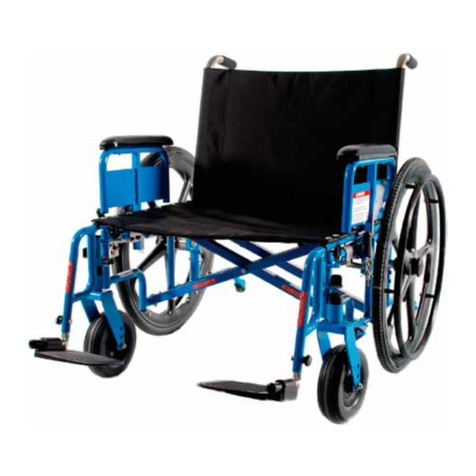
Graham Field
Graham Field Gendron 4000MRQ2 User manual
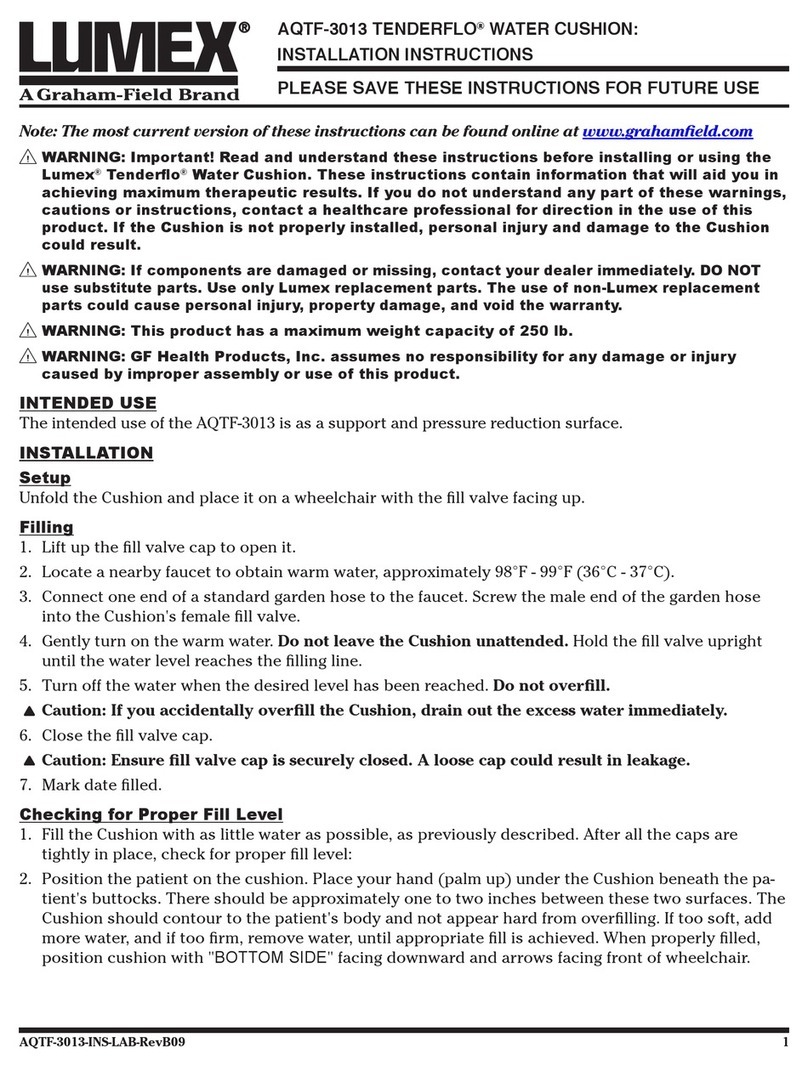
Graham Field
Graham Field Lumex TENDERFLO WATER CUSHION User manual
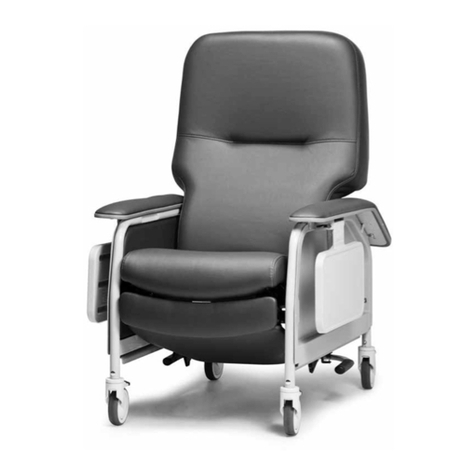
Graham Field
Graham Field LUMEX FR566G Series User manual
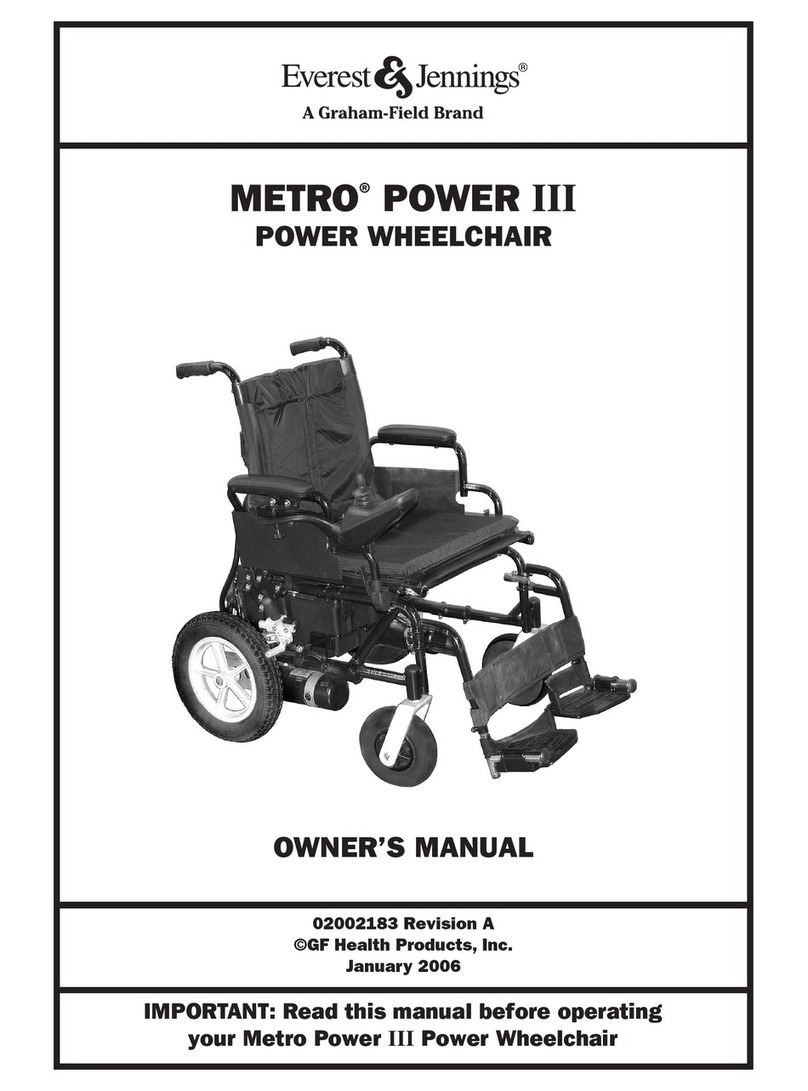
Graham Field
Graham Field METRO POWER III User manual
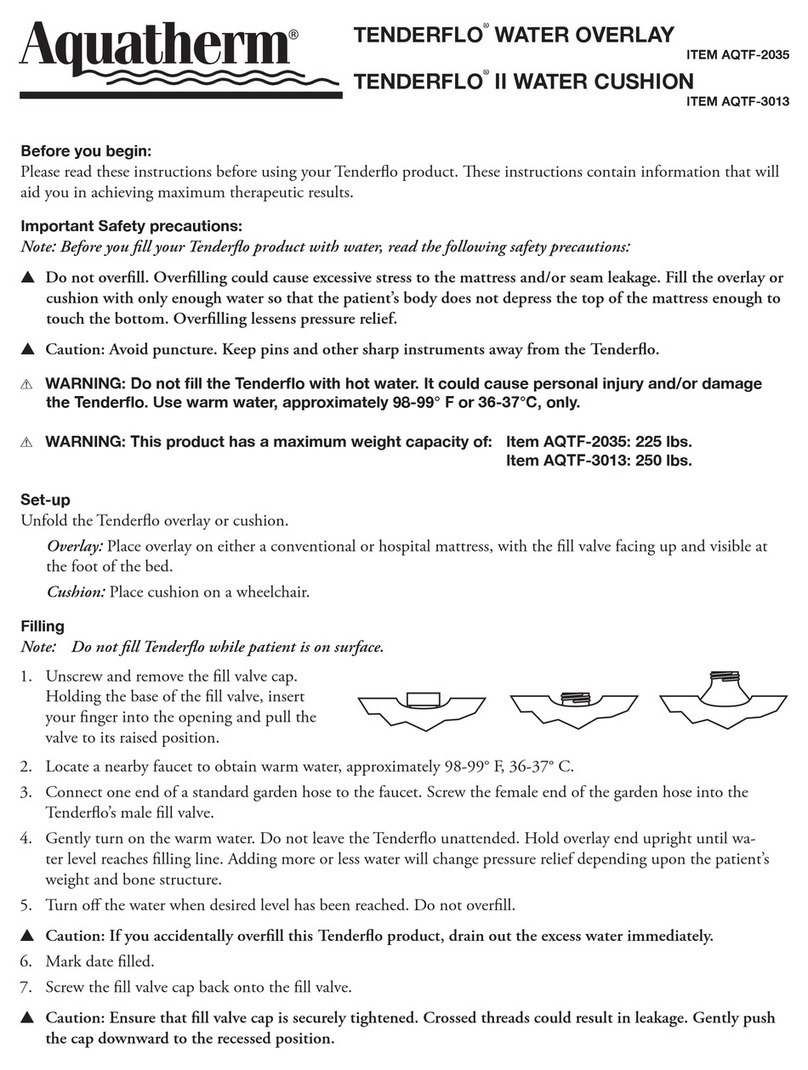
Graham Field
Graham Field TENDERFLO AQTF-2035 User manual
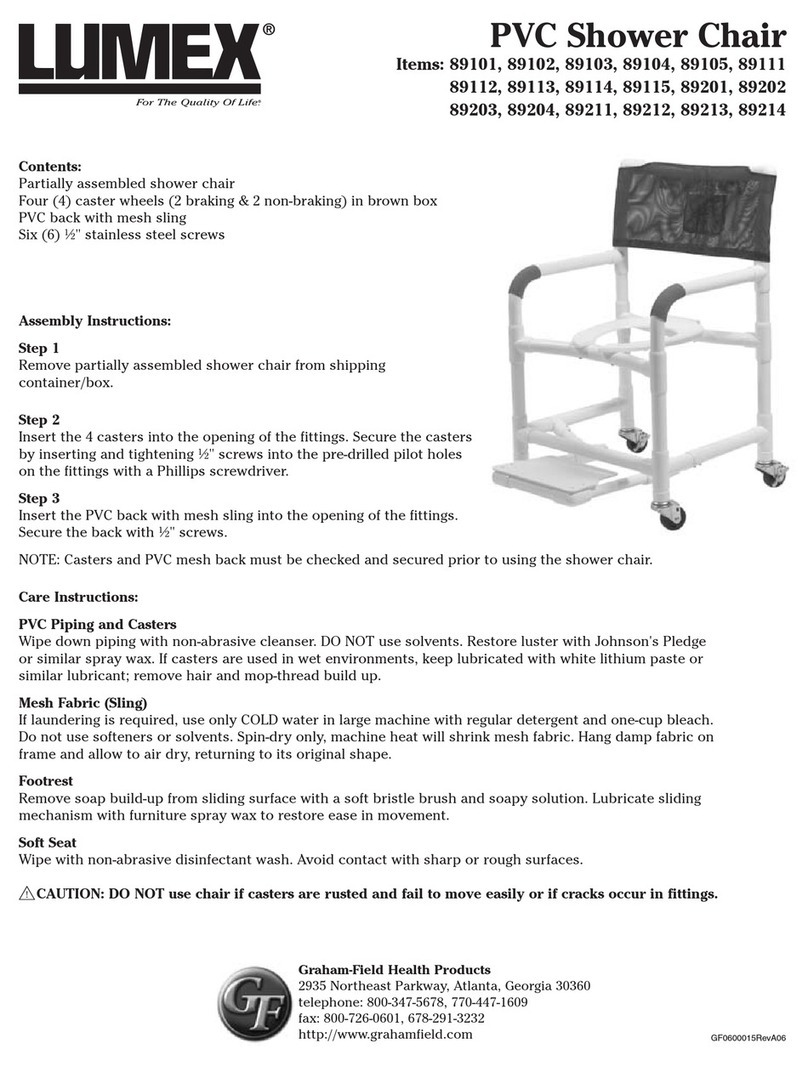
Graham Field
Graham Field LUMEX 89101 User manual
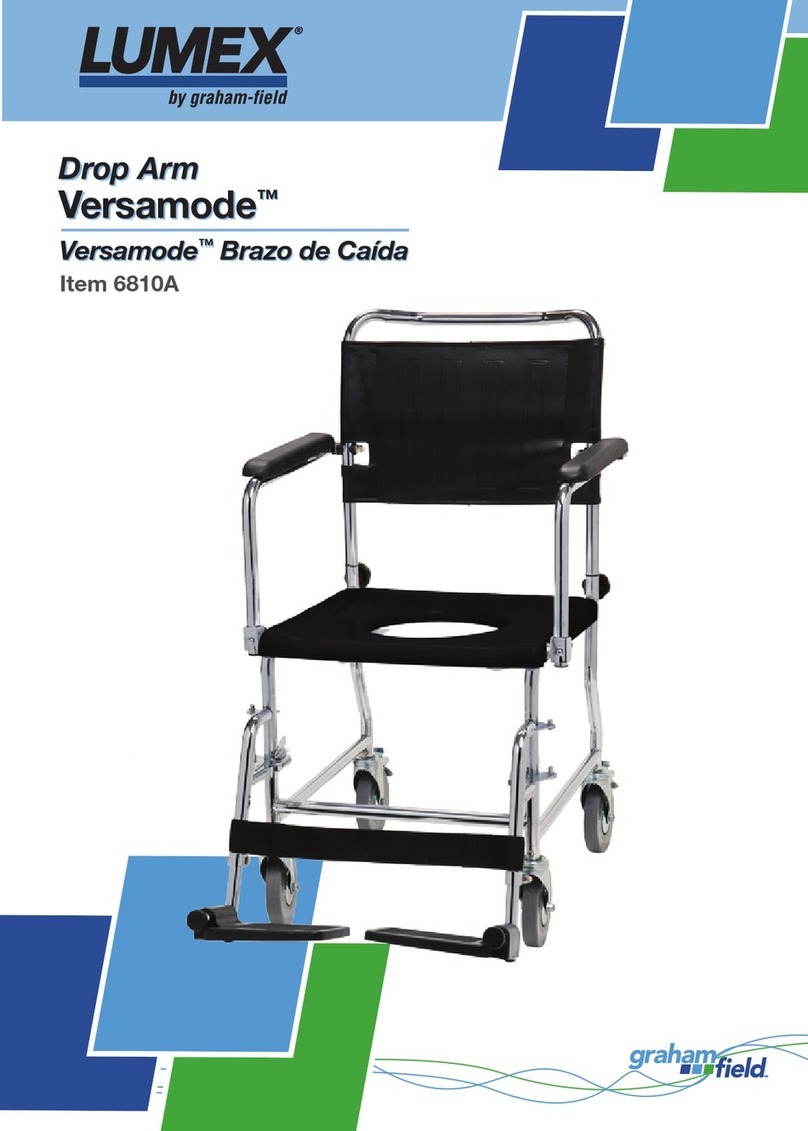
Graham Field
Graham Field LUMEX Versamode Drop Arm User manual
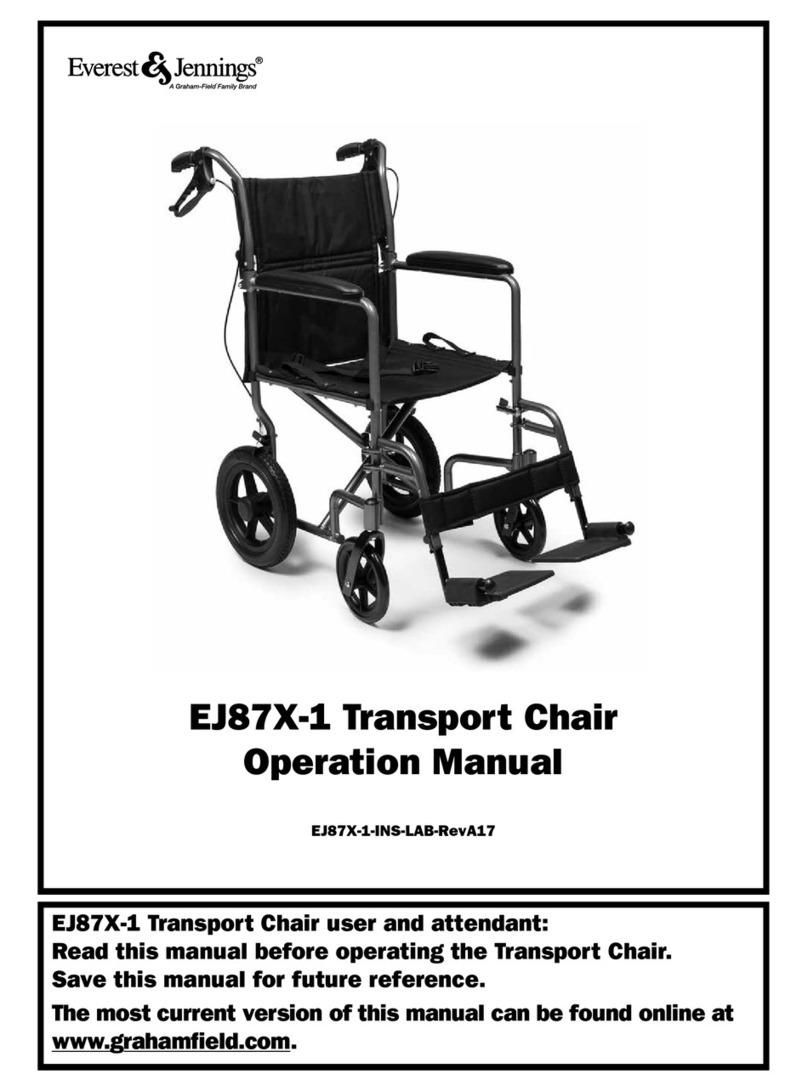
Graham Field
Graham Field Everest & Jennings EJ87X-1 User manual
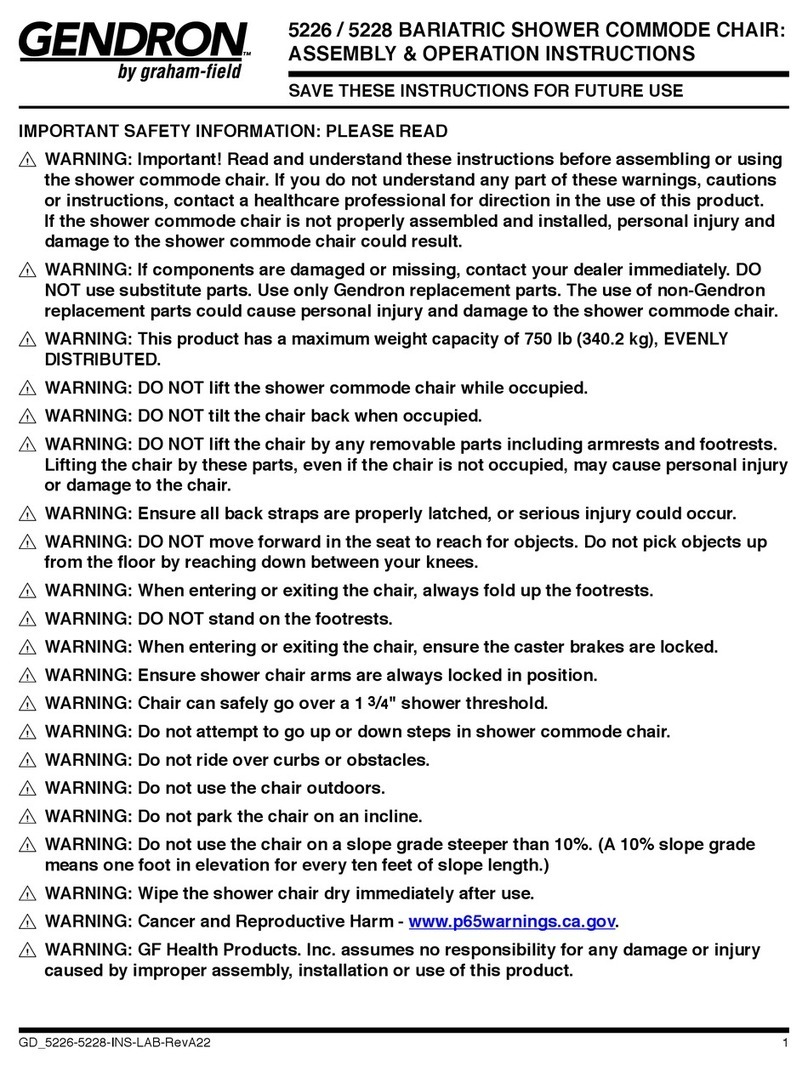
Graham Field
Graham Field 5226 Parts list manual

